Kenneth Kemble, El rey de los pordioseros (King of the Beggars), 1960. Mixed media on hardboard, 70 7/8 × 39 3/8 in. (180 × 100 cm). Collection of the Museo Nacional de Bellas Artes de Argentina
From the Desk of. . . invites scholars to fill gaps in English-language reference materials on Latin American art by developing research on movements, geographies, and methodologies.
On October 30, 1961, Martha Jackson, the New York–based gallerist of some of the greatest names of Abstract Expressionism and French Informalism, wrote to one of her artists, Antoni Tàpies, to inform him about the works that had recently traveled to Argentina for the painter’s solo exhibition. Letter from Martha Jackson to Antoni Tàpies, October 30, 1960, New York. Archive of the Fundació Antoni Tàpies, Barcelona. With relief, Jackson told him they had finally received payment for two of them, Architectonic (1960) and Tres formas con relieve (Three Shapes with Relief, 1960), acquired by the Museo Nacional de Bellas Arte in Buenos Aires (MNBA), and that she hoped the check would arrive in time to help him cover the expenses of his new house. In a handwritten note, she also explained that the other paintings were still in Montevideo, where they had traveled as part of the same solo exhibition that had been shown at the Instituto Torcuato Di Tella (ITDT) in Buenos Aires.
Participating in exhibitions organized by the Di Tella became a recurring event for artists who gravitated around Michel Tapié’s art autre. In his 1952 work Un art autre, Michel Tapié included Karel Appel, Alberto Burri, Jean Dubuffet, Jean Fautrier, and Lucio Fontana among his repertoire of artists. However, this register would change throughout the decade and would expand and become more flexible around 1965. Michel Tapié, Un art autre: où il s'agit de nouveaux dévidages du réel (Paris: Gabriel-Giraud et fils, 1952). A few years earlier, Alberto Burri had been contacted through the Italian critic Lionello Venturi to be the subject of a solo exhibition that, like Tàpies’s, would accompany the ITDT International Painting Prize in 1960. “Pogliani, who has notified me of Burri’s willingness, wants to know if there is any hope of selling a painting, which is to say, whether you will choose to keep one of the paintings sent to Buenos Aires. If you make me an offer, a positive sign, this would help Burri make up his mind.” Letter from Lionello Venturi to Torcuato Di Tella, Rome, July 14, 1960. ITDT Archive, CAV, Box 22, Collection 1960–70, quoted in Andrea Giunta, Avant-Garde, Internationalism, and Politics: Argentine Art in the Sixties (Durham: Duke University Press, 2007), 105. In a similar way, in 1963 the Parisian gallerist Rodolphe Stadler informed Antonio Saura that ITDT had asked him to take part in the 1963 International Prize and begged him to send his best works, as he believed he had a good chance of winning. “I received a letter from the Instituto Torcuato di Tella in which you are invited to participate at the Prix International de Peinture. I thought it would be good for you to participate in this demonstration and to do it with the best possible works, since I believe you have a chance to win the prize.” Letter from Rodolphe Stadler to Antonio Saura, April 12, 1962, Paris. Housed at the Antonio Saura Foundation, Geneva. Reproduced in “La galería Stadler en la trayectoria de Antonio Saura” [The Stadler gallery in the trajectory of Antonio Saura], Carolina Noronha Martínez (undergraduate thesis, University of Barcelona, 2013), 69. Unless otherwise noted, all translations in this article are mine.
Much like the ITDT, the galleries, museums, and artists that made up the Buenos Aires art scene also had their eye on European Informalism during the early 1960s. Since the late 1950s, European Informalism had been proclaimed as one of the main interlocutors in the renewal of the modern art that was produced and exhibited in Argentina, although this did not imply the automatic or unproblematic assimilation of the aesthetic and plastic principles of the movement. Although the geopolitical dynamics that have traditionally marked the discipline of art history invite us to conceive Informalism in Argentina as a peripheral offshoot of its European version, In this article I will follow the “horizontal” perspective proposed over the past few decades by art historians such as Piotr Piotrowski. Piotr Piotrowski, “Towards a Horizontal Art History” in Crossing Cultures. Conflict, Migration, and Convergence, ed. Jaynie Anderson (Melbourne: The Miegunyah Press, 2009). the main dynamics of “interculturalization” 1 that defined the Informalist movement between Argentina and Europe in the late 1950s and early 1960s indicate the opposite. The Argentine art scene approached the Informalism produced in Europe in a particularly selective manner and strategically transformed it, expanding its theoretical, institutional, and aesthetic boundaries beyond European confines.
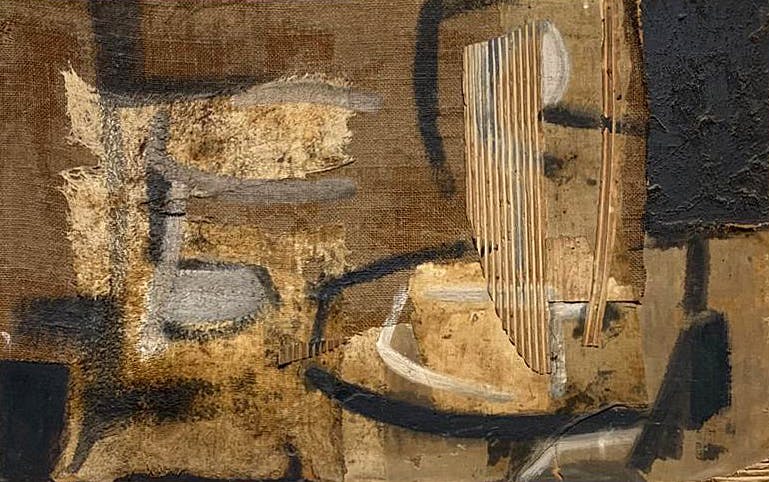
Kenneth Kemble, Untitled, n.d. Collage on hardboard, 20 3/8 × 31 7/8 in. (52 × 81 cm). Institute for Studies on Latin American Art (ISLAA), New York
Throughout the late 1950s, artists such as Kenneth Kemble, Alberto Greco, and Mario Pucciarelli saw in the movement a tool to break with the academicism and decorativeness they perceived in the Geometric Abstraction that was being produced in Argentina at the time. 2 During those years, European Informalism—understood from the perspective of Michel Tapié’s art autre—spread around the country through various channels: the trips that artists such as Greco and Kemble made to Europe; the close relationship between Argentine and French art criticism 3 ; and the circulation of the most important books on Informalist art, such as El arte otro, 4 by the Spanish art critic Juan Eduardo Cirlot, or Spazialismo 5 by the Italian Giampero Giani. At the same time, the lack of interest from New York galleries in promoting Abstract Expressionism in Latin America 6 also contributed to its European sibling receiving more attention in Argentina.
Although by 1957 solo and group exhibitions 7 would already demonstrate the interest of artists such as Martha Peluffo or Jorge López Anaya in Informalist aesthetics, the movement did not take hold in the capital until 1959. That year, a group of artists formed by Kemble, Greco, Pucciarelli, Enrique Barilari, Olga López, Fernando Maza, Towas, and Luis Alberto Wells proclaimed themselves as the Movimiento Informalista of Buenos Aires. In July, the group organized their first exhibition at the Galería van Riel and, in November, its second exhibition, at the Museo Municipal de Artes Plásticas Eduardo Sívori. 8
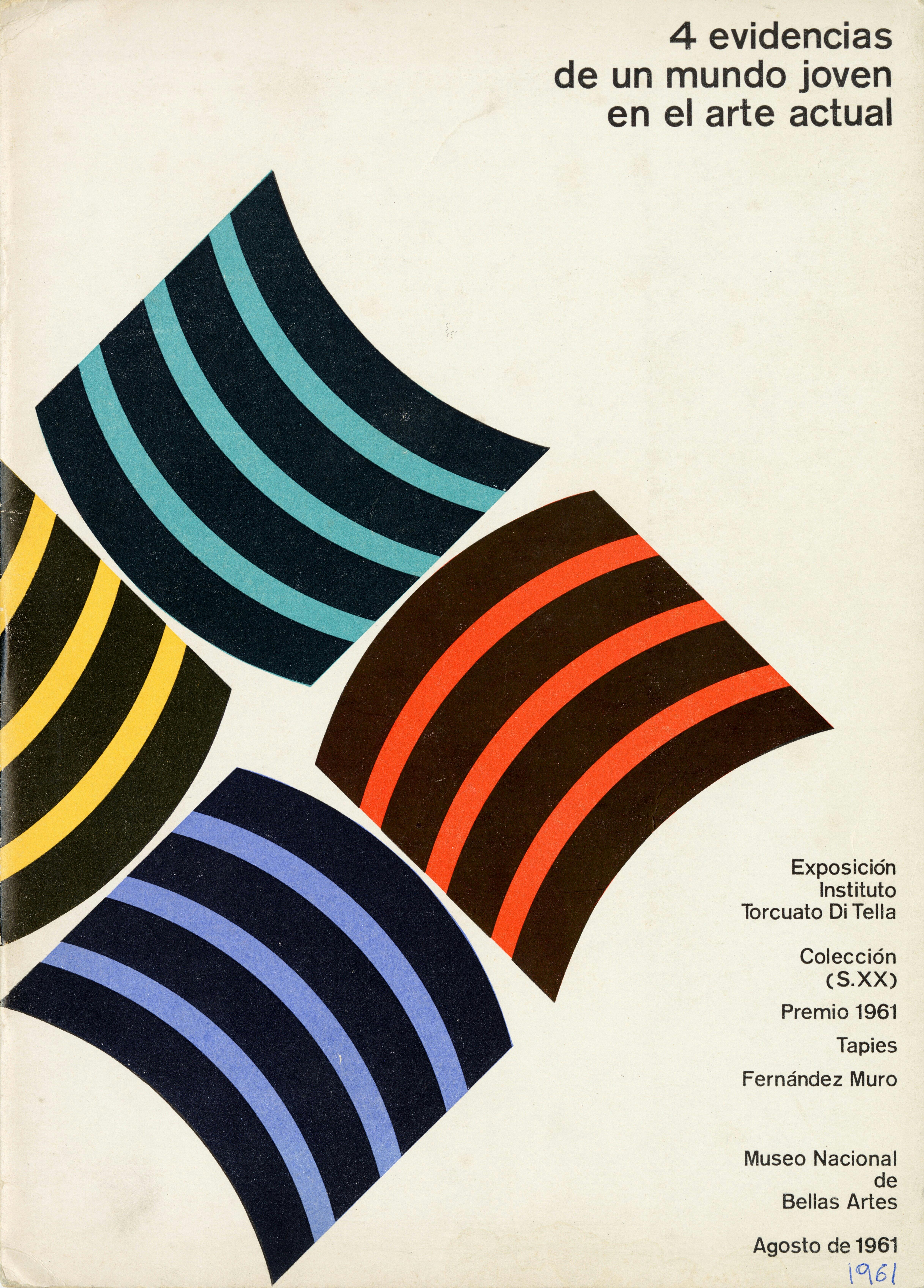
Cover of the catalogue for the exhibition Cuatro evidencias de un mundo joven en el arte actual (Four Evidences of a Young World in Today’s Art), organized by the Di Tella Institute at the Museo Nacional de Bellas Artes, 1961. Institute for Studies on Latin American Art (ISLAA) Library and Archives
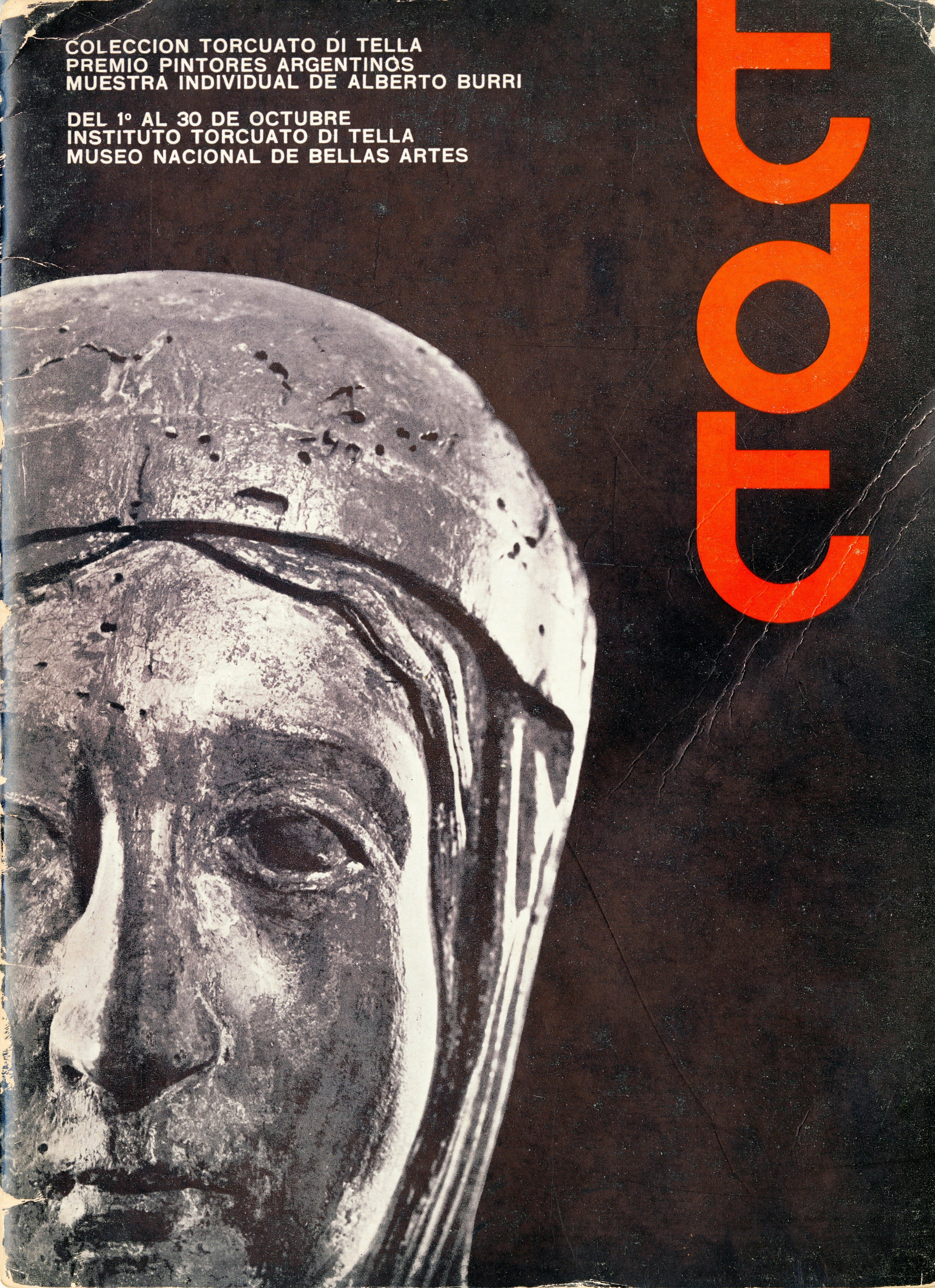
Cover of the catalogue for the triple exhibition organized by the Di Tella Institute at the Museo Nacional de Bellas Artes, 1960. Institute for Studies on Latin American Art (ISLAA) Library and Archives
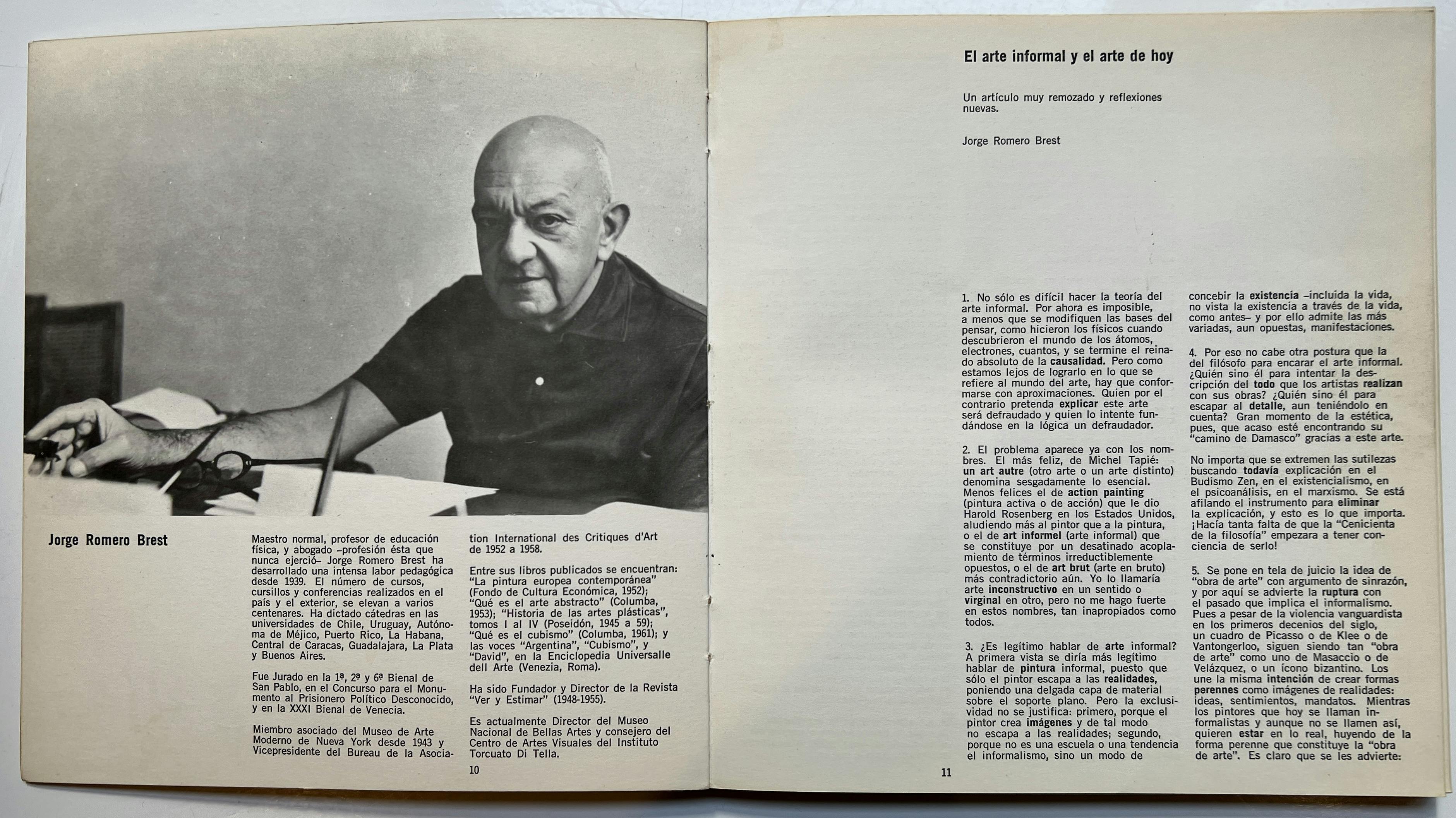
Jorge Romero Brest, “El arte informal y el arte de hoy: un artículo muy remozado y reflexiones nuevas,” in Premio Internacional de Pintura Instituto Torcuato Di Tella 1963 (Buenos Aires: Centro de Arte del Instituto Torcuato Di Tella, 1963). Institute for Studies on Latin American Art (ISLAA) Library and Archives
Throughout the late 1950s, artists such as Kenneth Kemble, Alberto Greco, and Mario Pucciarelli saw in Informalism a tool to break with the academicism and decorativeness they perceived in the Geometric Abstraction that was being produced in Argentina at the time.
The works exhibited in both shows revealed the great attention that Argentine painters paid to the most prominent names in European Informalism, especially, as Andrea Giunta has pointed out, to Spanish painters such as Tàpies, or to the Italian Alberto Burri. 9 In the Sívori exhibition, the gloomy palette of most of the works was reminiscent of the dark tones used by Saura or Modest Cuixart, just as the different torn layers that Wells superimposed on the canvas, or the cracked surfaces of Pucciarelli, pointed toward Burri’s lacerated and cracked surfaces.
Although the most conservative critics received these works with negative and even derisive reviews, 10 those who were more favorable reiterated the possible cross-references between local and foreign painters. For Hugo Parpagnoli, the generalized exploitation of the thickness of paint or the use of tools that went beyond the brush created “impastos, colors, vibrations, free graphics, roughness”Hugo Parpagnoli, “Pintura informal,” La Prensa (Buenos Aires), July 15, 1959. that faithfully adhered to the stylistic principles of Informalist art from Europe. The roughness of the oil paintings that Greco exhibited at Museo Sívori were successful imitations of “the plastering of old, peeling, and dirty walls in which it is amusing to look for figures, 11 a description that evoked Tàpies’s “walls,” as they had been described by European critics.
In addition to these similarities, which art historians have subsequently confirmed, 12 art critics of the time also showed how the Argentines, rather than following the European model, expanded it through irreverence and questioning. Still in 1959, Parpagnoli highlighted the unbeatable surprise that Kemble’s works had aroused at the 5.º Salón de arte nuevo (5th New Art Salon) due, not to his Informalist practice, but to his use of “rusty cans, moldy canvases, and some pieces of wood. 13 Just a few months later, in 1960, Kemble stated that Informalism was one of the three paths that, along with collage and graphics, made up his work. In this vein, at the second Movimiento Informalista exhibition at Sívori, Wells showed two paintings made with trunks and cans, and Greco presented works that seemed Informalist but whose technique transcended European principles. Behind the illusory surfaces of his paintings, rough and monochrome, there was a performative aspect that would emerge during the 1960s and which already announced the poetics of Destructive Art: 14 the canvases had been painted with oil, pitch, and soot and exposed to different alterations. Greco either placed them on his balcony for the weather to intervene on, or he urinated on them—something he would ask his friends to do as well.
From the outset, the Informalist initiatives that emerged in Buenos Aires proposed notorious deviations from their European counterparts 15 and were particularly short-lived. 16 Some of the Argentine artists who interacted with Informalism did so with insolence, taking its principles to the limit and using the answers that the Europeans had arrived at as starting points for their own aesthetic research. Instead of cloistering themselves in the official poetics stemming from Paris, artists such as Greco, Kemble or Wells deftly took advantage of Informalism’s aesthetic potential to explore the tendency toward dematerialization, the questioning of the objectual quality of the artwork, and the destructive condition inherent to all creative processes.
Without accepting the supposed consideration of European art as a “model,” 17 Argentine artists played with Informalism on their own terms, as did the most important institutions of the time. Since the outbreak of the Revolución Libertadora in 1955, Argentine art institutions worked to turn the country into an international hub, exporter, and importer of art. 18 In Buenos Aires, exhibiting and collecting European Informalism became a key strategy to project an avant-garde art that would fit in with the art that was in vogue at the main cultural centers, but whose repertoire was also distinct and original.
As Andrea Giunta and Ana Longoni have defended, 19 the institutionalization of Informalism in Argentina was a softened one, presenting the movement’s works as novel at a time when, as we have just seen, the local avant-garde had already approached such poetics in a very particular way. However, this institutional moderation of Informalism can also be explained in strategic terms, as a way of responding to the country’s artistic and political needs. One of the key figures of this project was Rafael Squirru, director of the Museo de Arte Moderno de Buenos Aires (MAM, known today by the acronym MAMBA) since its foundation in 1956, and responsible for the organization in 1959 of the exhibition Movimiento Informalista (Informalist Movement) at the Museo Sívori.

Alberto Greco works on a painting, ca. April–May 1960. Courtesy Centro de Estudios Espigas-Fundación Espigas

Alberto Greco, Untitled, 1960. Screenprint, 19 5/8 × 13 3/4 in. (49.9 × 34.9 cm). Institute for Studies on Latin American Art (ISLAA), New York
Some of the Argentine artists who interacted with Informalism did so with insolence, taking its principles to the limit and using the answers that the Europeans had arrived at as starting points for their own aesthetic research.
In the prologue 20 that introduced the catalogue of said exhibition, Squirru described how, from his point of view, the institutionalization of Informalism in Argentina would be achieved by articulating local and contemporary European art production. From a prominently philosophical perspective, Squirru explained how European Informalism had overcome the prevailing Cartesian rationalism of Western modernity to strengthen its links with the Zen Buddhist tradition. In addition to the strong spiritual conception of the movement promoted by Michel Tapié and Charles Estienne, Squirru pointed out the kinship between Informalism and Zen poetry in the use of humble materials, opaque colors, and the dialogue between subject and work.Squirru, 21 While the text ratified the European theoretical trend, it also included references to the local intelligentsia. In describing the spiritual tendency of Informalist art, Squirru mentioned the Argentine writer Federico González Frías as an example of such spirituality and, toward the end of the text, outlined the way in which each of the artists in the exhibition inflected Informalism in their own terms.
This blending of the French discourse and the peculiarities of local production was also reflected in the Primera Exposición Internacional de Arte Moderno de Argentina (First International Exhibition of Modern Art in Argentina), celebrated at MAM in 1960. Of the more than one hundred and thirty Argentine artists exhibited, the vast majority flirted in one way or another with Informalism. In the Spanish section, Cuixart and Tàpies stood out; in the French one, Jean Fautrier and Pierre Soulages; and in the American one, Willem de Kooning, Franz Kline, Jackson Pollock, and Mark Tobey, whose work was rarely seen in Buenos Aires at that time. 22
As Squirru explained in the prologue of the catalogue, significantly written in Spanish, English, and French, the exhibition was to be understood as “the realization of a national aspiration” 23 that opened the doors to a new muse. Through vague and poetic prose, Squirru constantly overlapped the artistic novelty that the museum represented with a “new sensibility” that governed the world. Defending the accuracy of the political and artistic modernization of Argentina, the critic also warned that adhering to the new trends was not, however, a mere exercise of imitation: “Our position is affirmative: we have not chosen to mimic in order to look good,” he declared.
The prominent position that Informalism occupied in the First International Exhibition was not, thus, the result of an ambition to be on par with the great Western art powers but of recognizing the country’s needs. Squirru included Informalism among the artistic movements whose “generosity, courage, and tenderness” made it possible to “overcome the dangerous aspect of nationalism.” Exhibiting Informalist art was a symptom that the sensibility of a “new man” was flourishing in Argentina, a sensibility that, for Squirru, was directly linked to his fervent anti-Peronism. 24 Together with other intellectuals of the time, such as the aforementioned González Frías, Squirru conceived of this “new man” as the figure who would lead the country’s transformation through his creative freedom and reluctancy to political partisanship. The “new man” was deeply connected to the people and felt that all humanity was united by a common destiny to which he hoped to contribute. In this sense, associating European Informalism with the sensibility of this new messianic figure resulted in a complete redefinition of the movement’s ideological principles.
The institutional recognition of European Informalism came about, then, from an internationalist imperative and a strategy of affiliation that stripped the movement of the tormented attitude Paris had ascribed to it, in order to, instead, charge it with optimism. From the awareness that “everything profound has roots somewhere,” 25 in Argentina, Squirru promoted a vision of Informalism that did not relate to the disenchantment and loss of faith in humankind that the disasters of the war had left in Europe. Quite on the contrary, exhibiting, collecting, and producing Informalist art expressed a vitalist trust in humanity and in the possibility of changing the world.
The political needs of the country were not, however, the only local condition that the institutionalization of Informalism had to accommodate. Around 1961, alternative avant-garde styles began to be explored in the Argentine scene, based on a return to figuration and the development of an “aesthetic of negation” 26 that promoted experimentation with objects, site-specific works, and performative practices. The coexistence of trends became a defining feature of Argentine art after 1964, a year when the eruption of such practices was so strong that the media came to consider it as “the year of the avant-garde.” 27 Faced with such a situation, ITDT—at that time a newcomer to the Buenos Aires art scene—and Jorge Romero Brest adopted an afiliation strategy similar, although not identical, to the one used by Squirru, choosing to establish a constant dialogue between Informalism and the works that the foundation was acquiring, from both the European artistic tradition and contemporary artistic trends.

Rafael Squirru hangs a poster for the exhibition Movimiento informalista at the Museo Sívori, 1959. Courtesy Eloisa Squirru

Rafael Squirru admiring an abstract painting at the Museo de Arte Moderno de Buenos Aires, n.d. Courtesy Eloisa Squirru
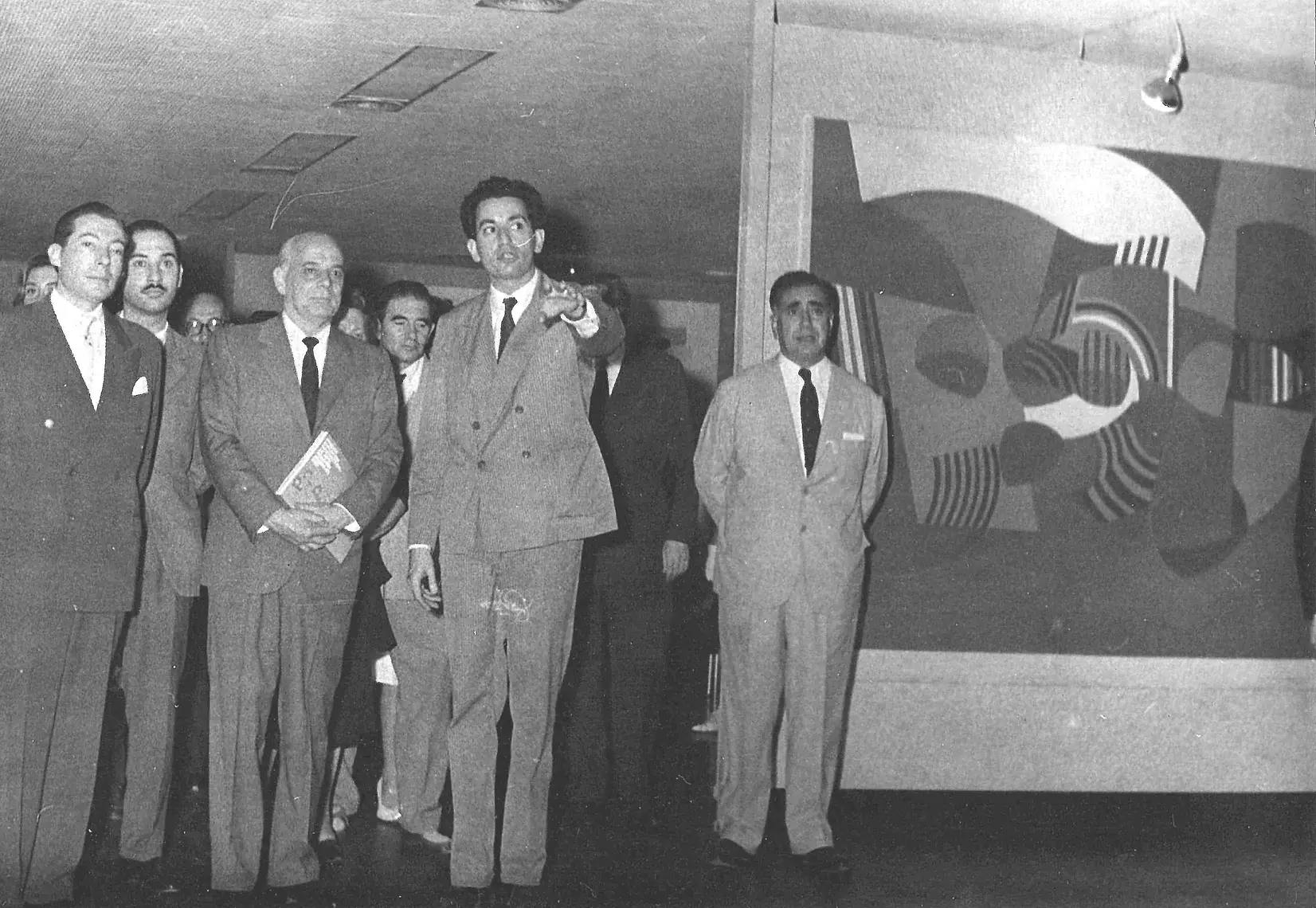
Rafael Squirru at the opening of the Museo de Arte Moderno de Buenos Aires, ca. 1960. Courtesy Eloisa Squirru
Instead of cloistering themselves in the official poetics stemming from Paris, artists such as Greco, Kemble or Wells deftly took advantage of Informalism’s aesthetic potential to explore the tendency toward dematerialization, the questioning of the objectual quality of the artwork, and the destructive condition inherent to all creative processes.
ITDT began its own internationalist struggle with, in the words of Andrea Giunta, a “triple extravaganza” 28 organized at the Museo Nacional de Buenos Aires (MNBA) in 1960: the simultaneous exhibition of ITDT’s permanent collection, the first Di Tella Prize for Argentine Painters, and the aforementioned exhibition of twenty-one works by Alberto Burri. 29 The event was made possible by the collaboration of Jorge Romero Brest, who at the time was director of MNBA and had been contacted by Torcuato Di Tella to take charge of his collection on loan. As Kemble attested in one of his newspaper reviews, the fact that the three events took place at the same time opened the door for a Tintoretto, a Picasso, and a Burri to be understood side by side. 30 This gesture, beyond creating the opportunity to see the great masters of art exhibited in the same place, proposed an implicit continuity between the Western tradition, European Informalism, and Argentina’s art scene.
Due to the event’s success, in 1961 ITDT repeated this exhibition model with some slight changes. Under the unifying title of Cuatro evidencias de un mundo joven en el arte actual 31 (Four Evidences of a Young World in Today’s Art), the Second Di Tella Prize for Argentine Painters was presented together with a solo exhibition by a foreign artist—in this case Tàpies—in addition to a show by an Argentine artist, the “intuitive” 32 abstract painter José Antonio Fernández-Muro, 33 and ITDT’s collection, this time limited to twentieth-century works. On the one hand, these changes, as indicated by the global title of the event, aimed to reinforce the ideas of youth and contemporaneity that ITDT intended to represent. On the other hand, the addition of a solo exhibition of a contemporary local artist made even more evident the equivalence that the institution was trying to establish between the two group exhibitions and the two solo ones. The young Argentine painters who had been shortlisted for the prize—which was ultimately won by the Informalist Mario Pucciarelli —stood as direct heirs of the modern eminences, while Argentine painters such as Férnandez-Muro were compared to foreign painters such as Tàpies.
As in the previous edition, the reviews of the event attested to the effectiveness of ITDT’s strategy. In the pages of the Buenos Aires Herald, Kemble argued that “the spontaneous attraction of the simple and direct color planes” 34 in Fernández-Muro’s works was cloying next to the works of Tàpies. But despite Kemble’s negative judgement, the critic’s observation ratified the equivalence proposed by ITDT as a way to understand Informalism. Following the same comparative dynamic, in the magazine Sur, Hugo Parpagnoli contrasted the “memory of luminous perfection” 35 that Fernández-Muro had left him, with the “somewhat tragic memory” of the Catalan artist, considering them as two sides of the same coin.
This strategy of equivalences and affiliation that ITDT used with Informalism was crowned by Jorge Romero Brest’s resemanticization 36 of the movement after accepting the position of director at ITDT’s Center for Visual Arts and resigning as director of of MNBA in 1963. That same year, in the catalogue of ITDT’s First International Painting Prize, Romero Brest published El arte informal y el arte de hoy (Informal Art and the Art of Today), 37 where the critic expanded on one of the movement’s basic principles that Tapié had delineated in 1951, according to which Informalist artists were the only one who could have access to the inexhaustible of “the Real.” 38 Recognizing Tapié’s difficulties at that time in finding strictly Informalist artists with whom to thicken his catalogue, Romero Brest chose to consider Informalism as an aesthetic attitude rather than an artistic movement. Through an explanation with a markedly philosophical tone, the critic argued that the Informalist artist had been responsible for separating the idea of the Real from the notion of reality, positing the former in terms of “a truth that is obtained by imagining what exists.” 39 Informalism had discovered that the task of modern art was precisely to discover that Real, a task that could not only be carried out from Informalist plastic practices but from various media and trends.
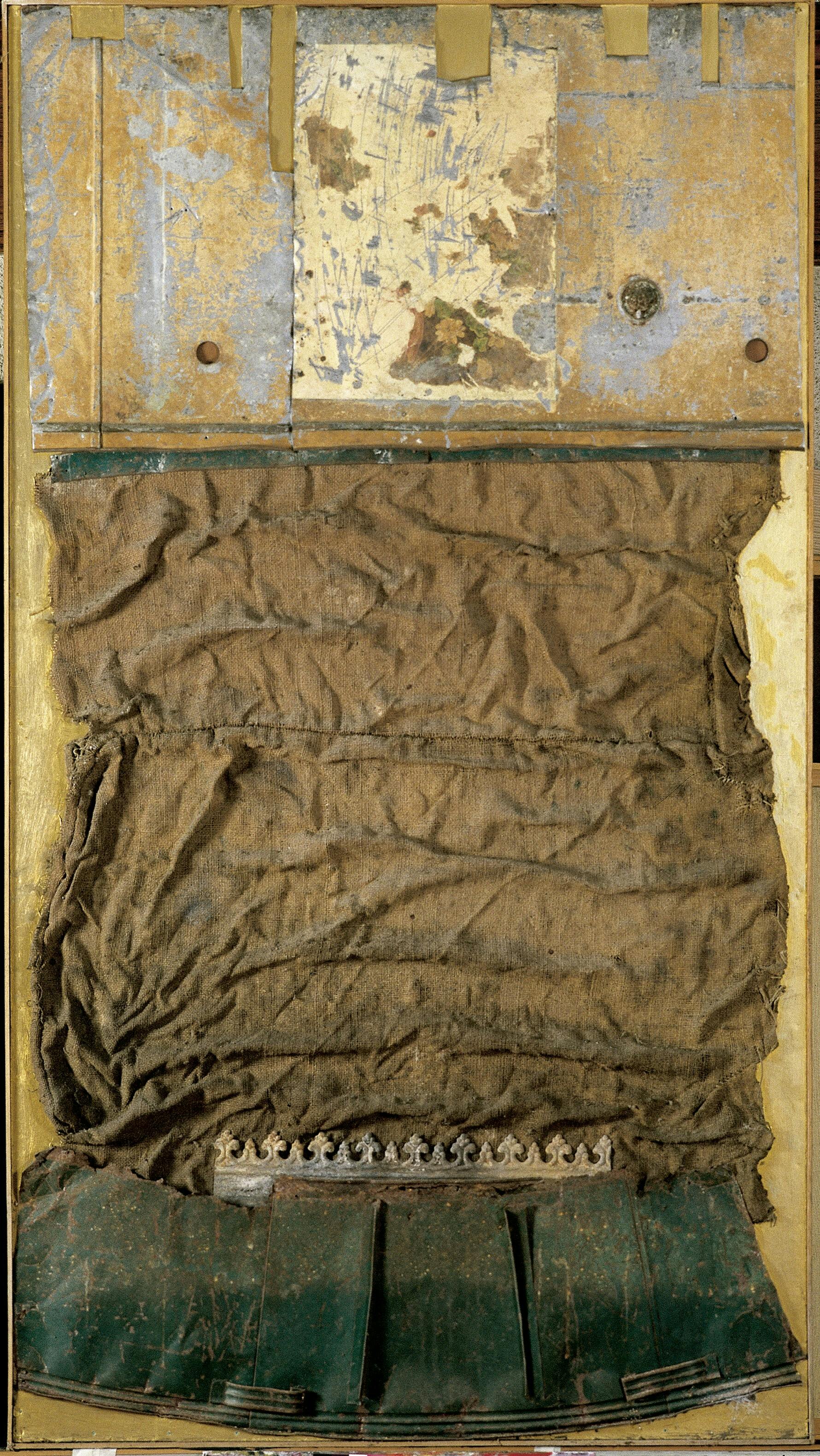
Kenneth Kemble, El rey de los pordioseros (King of the Beggars), 1960. Mixed media on hardboard, 70 7/8 × 39 3/8 in. (180 × 100 cm). Collection of the Museo Nacional de Bellas Artes de Argentina
Critics such as Rafael Squirru or Jorge Romero Brest promoted exhibition programs in which Informalism functioned as a hinge between the European tradition, the international contemporary scene, and local artistic production. In this way, during the 1960s institutions such as ITDT or MAM turned Buenos Aires into a prominent enclave within the international art network, where Informalists were able to promote the sale, circulation, and recognition of their work.
Through this theoretical reelaboration, Romero Brest allowed for the interest in the object and figuration of the new artistic movements to be understood in continuity with Informalist abstraction. The theoretical apparatus developed by the critic thus reinforced the dynamic of equivalences proposed by ITDT’s exhibition program and opened the possibility of creating artistic genealogies that were more difficult to conceive in the supposed “centers” of contemporary art. In this way, it would not be surprising that the following year, in 1964, shortly before the National ITDT Prize was awarded to Marta Minujín 40 for her multicolored mattress structures, ITDT held an exhibition with the latest proposal by Tapié. 41 Romero Brest showed his sympathy towards Minujín by supporting her candidacy in the final decision for the award, 42 but this did not prevent him from showing it also for Tapié, whom he would praise in the 1964 exhibition catalogue. ITDT allowed the cohabitation of artistic trends that the centers saw as opposites, proclaiming themselves as the enclave where the affiliation that existed between them could be appreciated.
Informalism in Argentina never became as cohesive a movement as in Europe, nor did it develop quite as programmatically. Compared to their European colleagues, Argentine artists incorporated alternative materials into their works much earlier and were more reluctant to be pigeonholed solely as Informalists. From the beginning, the approach to Informalist aesthetics was also accompanied by its questioning, which led artists to work with the limits of painting, its objectual condition, and the creation/destruction opposition. As a distinct artistic movement, Informalism was especially fleeting in Argentina, although as an aesthetic attitude its impact was much greater.
While at the plastic level Informalism was “an open door to other experiences” 43 far from the aesthetic programs of the European continent, at the institutional level it was also treated from a particular point of view. Although in Europe it had been interpreted as a response to the postwar climate or a plastic translation of the existentialist attitude derived from the Second World War, in Argentina Informalism was associated with the national reconstruction project of the first post-Peronist period. The internationalist insistence that, on a cultural level, shaped this project, led critics such as Rafael Squirru or Jorge Romero Brest to promote exhibition programs in which Informalism functioned as a hinge between the European tradition, the international contemporary scene, and local artistic production. In this way, during the 1960s institutions such as ITDT or MAM turned Buenos Aires into a prominent enclave within the international art network, where Informalists were able to promote the sale, circulation, and recognition of their work.
Informalism in Argentina was not a branch of the European version but rather expanded the rhythms and discourses that had guided the movement until then. Conditioned by their own advantages and limitations in the project of artistic modernization, Argentine critics and artists thought and practiced Informalism based on its possibilities and not on its guidelines. Despite the apparent aesthetic similarities between Argentine and foreign artists and the flattering attitude of the institutions toward the latter, the meanings with which European Informalism was charged were not able to respond to local needs. In Argentina, Informalism was a much more flexible art, both plastically and discursively. In the late 1950s and early 1960s, the Buenos Aires art scene witnessed Informalism’s last curveball, leaving its mark on the multiple temporalities and meanings that constituted the movement, transporting it beyond its center.